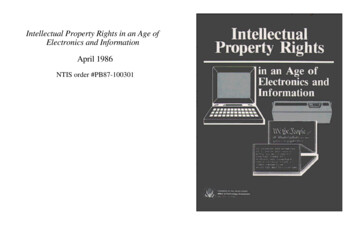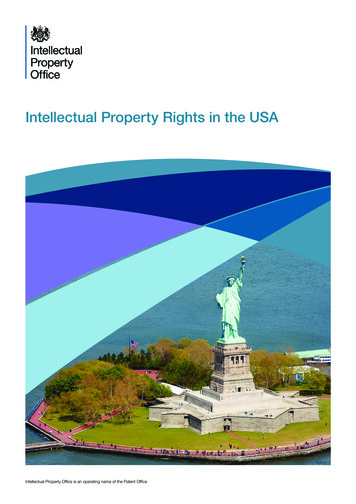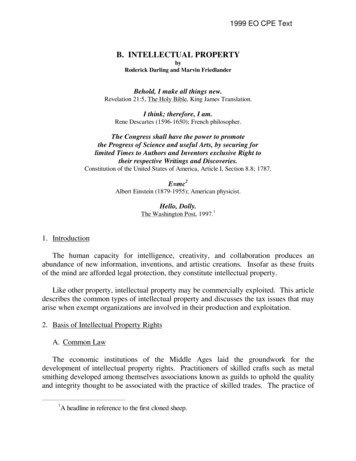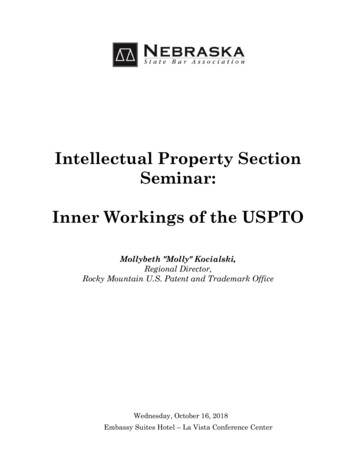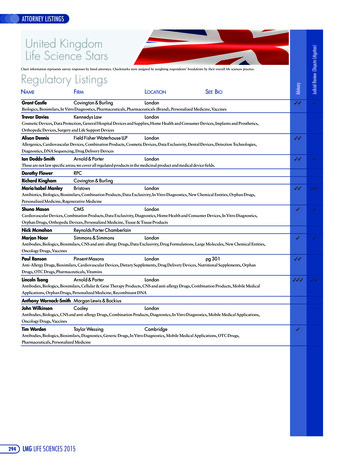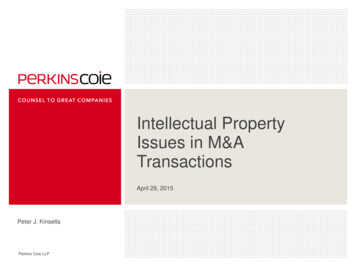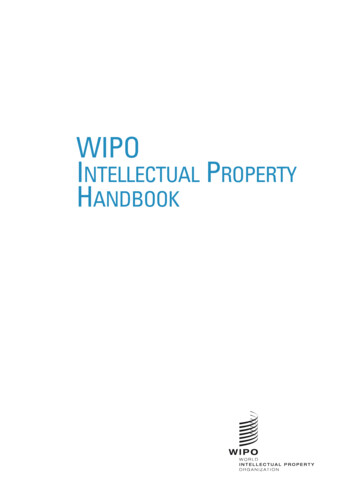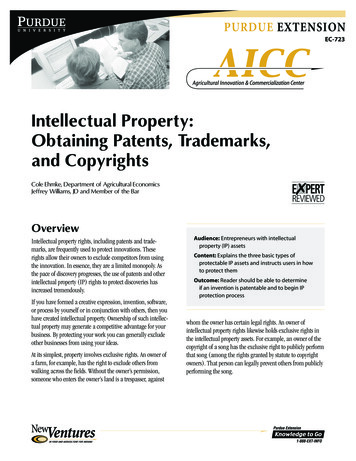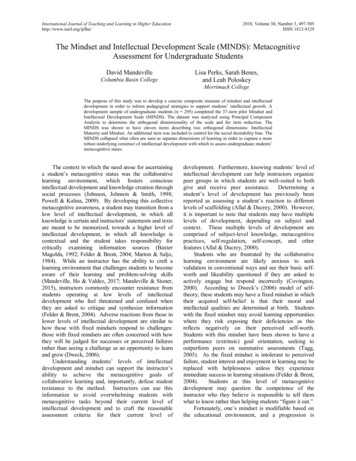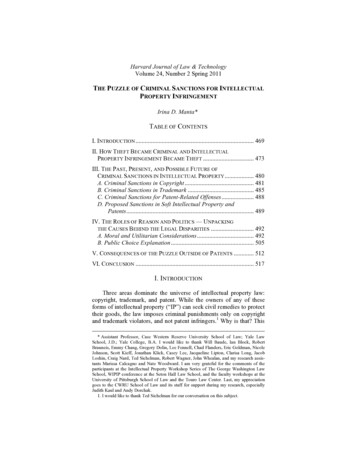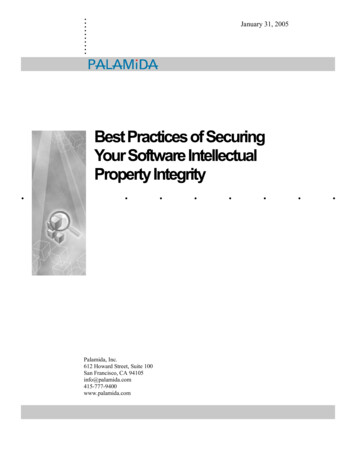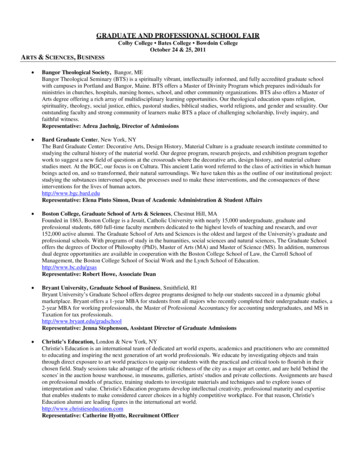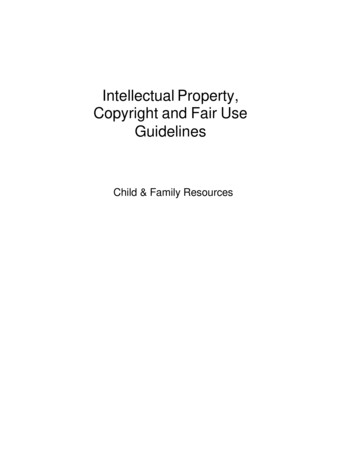
Transcription
Intellectual Property,Copyright and Fair UseGuidelinesChild & Family Resources
Objectives1. Provide the background to help insure that instructors, consultants and students haveappropriate information and resources about the use of intellectual property and copyrightedmaterials. Basic areas include:a. Knowledge of the basic concepts and principles of intellectual property, and theproperty rights attached to intellectual property.b. Knowledge of the concepts of ‘Moral Rights’ and ‘Fair Dealing ‘c. The ability to distinguish the legal implications of between personal, educational andcommercial uses of protected works.d. The principles of Fair Use and how they apply in instructor and learner usage.2. Discuss the instructor’s role in this effort, as a guide and a role model for ethicalbehavior.3. Describe the resources available for teaching learners about IP and copyright issues
A Little BackgroundCopyright has a relatively short history compared to other laws, and it helps to understand how ourCopyright Law developed. Understanding how the law protects private interests, while it restrictssome freedoms is important to help us accept the law, and perhaps understand the real issues.Some highlights: The Statute of Anne, 1710: Codified author ownership and established copyrights for aterm of 14 yrs., plus one renewal term.U.S Constitution, 1787: Established the basic premises of protecting the rights of theauthor for limited times and ensuring public access to ‘useful information.’Copyright Act of 1790: Established basic tenants of copyright law, based on Britishmodel, and the established the term of 14 yrs. plus one renewal.1870 Revision: Removed administration of copyright law from local courts and placed itwithin the Library of Congress.1909 Revision: Extended the copyright terms to 28 yrs. and one 28 yr. renewal.Copyright Act of 1976. The last major revision of the laws. Established a new copyrightterm: the life of the author, plus 50 years.1998 Berne Convention Brought U.S. Copyright Law closer to international practice.Eliminated the requirements for copyright marking.1992 Amendment to Title17 Section 304: Renewal of copyright became automatic.1998 Copyright Term Extension Act: Major blow to Public Domain, extended thecopyright term to life of the author plus 70 years, or 95 years from publication for worksmade for hire.Why Instructors, Consultants, and Learners Need To Know AboutIntellectual Property And CopyrightIn providing professional development training, we get involved with copyright and intellectualproperty issues the two major ways: In response to course work learners produce papers, projects, presentations, websites, art works, videos, multimedia, and music performances- all of which are madericher, more interesting and more effective by the judicious use of quotations, visuals,media clips and other copyrighted resources drawn from the real world. As result of their learning and experience, instructors, consultants, and learners willproduce original and creative works that have value for personal use, portfolios andperhaps for or future commercial use.As a result, instructors, consultants, and learners need to understand the basic concepts andprinciples behind intellectual property and the legal methods employed to protect thoseproducts from unauthorized use.Just as we understand that plagiarizing written works is dishonest, we need to recognize thatoutside certain limited conditions- unauthorized appropriation of non-text material is illegal.The use of copyrighted photographs, drawings, charts, video, audio, software, animations andother types of creative products outside those narrow boundaries, is not just unethical.
Copyright infringement is against the law and it can lead to criminal charges.One of the greatest dangers is that an instructor, consultant, or learner will carrymisinformation or careless behavior from personal uses to professional use. Attitudes such as‘I don’t think there’s anything wrong. ’ ‘Everyone else does it.’ ‘It isn’t really hurting anybody.’or ‘They won’t catch me.’ will create major difficulties when carried over into the workplace.What Do Instructors, Consultants, And Learners Need To Know?To protect ourselves and understand copyright issues inside and external to Child & FamilyResources, we need to know the basics about: Intellectual property and the legal measures used to protect it: copyright, trademarks,service marks, trade secrets, and patents.Who owns intellectual property, and what rights are reserved in the roles of instructor,consultant, or l e a r n e r .Specifics about copyright: what can be copyrighted, what those rights are, the terms ofcopyright protection and the meaning of ‘public domain’.The meaning of Fair Use’ and how it applies to our work and to learners.How to research copyrights and how to request permission to use copyrighted material.Basic Terminology/ConceptsThere are basic terms and concepts we need to be familiar with in order to work with intellectualproperty and copyrighted material; and be on firm legal footing. More detailed information aboutthese items can be found using the resources cited at the end of this guide. Intellectual Property: The intangible value we place on original, creative work: the ideasand concepts, and the physical things that represent that effort. Inventions, songs,paintings, formulas, designs, and the models, recordings, products etc. that result from orrepresent the creative effort. Copyright, Trademark, Service Marks, Trade Secret, Patent: The property rightsassigned by law to protect intellectual property. Copyrights and patents are the mostfamiliar, but we see trademarks and service marks all around us, and the trade secret isoften used as a marketing device. What Can Be Copyrighted? Fiction or non-fiction writings, photographs, drawings, models,designs, software, formulas, performances and recordings of dramatic or musical works- nearly any work of intellectual expression; as long as three conditions are met: 1.) It isoriginal, 2.) It includes a degree of creativity, and 3.) It is in a fixed format. Facts, data andother non-creative expression cannot be copyrighted- but the ‘expression’ of those facts,in a chart or graph for example, may be. The 4 Rights in Copyright, “All Rights Reserved’. Copyrights include: the right toreproduce, distribute, display or perform the work in public, and the right to createderivatives of the original work. Rights may be unbundled. ‘All rights reserved ‘ means justthat. Infringement, Contributory Infringement. An infringement is any action, deliberate orunknowing, that violates the rights protected by copyright, without permission of the owner.
If your actions make it possible for someone else to infringe a copyright, you could becharged with contributory infringement. Who Owns the Rights? Typically, the author or creator alone owns the copyright. If thereare multiple authors they share the copyrights. Copyrights can be given away, sold ornegotiated as part of a contract. Works Made for Hire. The employer owns all copyrightable or patentable works created byemployees within the scope of work defined for the job. Commissioned works, and thosecommissioned as part of a collective work are works for hire. Written contracts andagreements may stipulate the employer’s ownership of the work. Term of Copyright. The law defines the period that copyright remains in effect. Forindividual works, the term is for the life of the author plus 70 years. For works for hire, theterm lasts for 95 years from the first date of publication. As a good rule of thumb: assumethat any individual work created after 1923 and any commercial works published after 1908will still be under copyright.Fixed Works. Works are not copyrightable until they are expressed in a format that istangible or accessible for others to read or use. Copyright is automatic upon ‘fixing the work.Registration with the Copyright Office is not required. Copyright Marks. The use of copyright marks: the symbol or the long format - Copyright2004, John C. Jones are no longer required. The absence of copyright marks does notmean the work is free to use. Public Domain. Works in the public domain are free to for anyone to use without limitation.Works go into public domain when: 1) The original copyright expires and has not beenrenewed, or 2.) When the original author clearly designates the work for public domain.Certain government works (but not all) also are designated for the public domain.However- the published versions or editions of works in the public domain are copyrighted.This caution is particularly important for works of fiction, art, music, etc. Fair Use, the Fair Use Test. Fair use is a principle in Copyright Law that provides us with alimited ability to use copyrighted material without getting permission for limited purposes:personal use, non-profit uses, education, criticism or commentary, news reporting andparody. There are no hard rules to determine if an intended use is a Fair Use, but there are‘test criteria’ to help in making the decision:1. What is the purpose and character of the intended use?2. What is the nature of the copyrighted work?3. How much of the work will be used? And how important is that part?4. How would widespread use of this work impact its market value? Getting Permission- Why? When? And How? Why? To avoid the effort and expenserequired to defend against and infringement claim. You should get permission anytime youwant to use work in a way that does not ‘fit’ the criteria for Fair Use or there is a stronglikelihood the material will be incorporated in a work for commercial distribution. The U.S.Copyright Office has resources to help you research and request permissions.
Context of UsePersonal Use Beliefs about what we are permitted to do with ‘our property’ are deeply embedded.We have no doubt that when we purchase or acquire something; it is ours to do with as we please.We purchase a book, read it, give it to a friend, sell it in a yard sale, and donate it to a book drive ordiscard it without thinking anything of it. That’s common practice. The problem is that it fosters afeeling that we can do the same with any other products we purchase, so we copy music CDs, burndisks from downloaded music and video files, mount software on our desktop and our laptop, download the great things we find on the web, etc., all of the while overlooking an important fact. Most ofthese actions are acceptable when limited to your personal use, but the moment you burn a‘copy’ to give to a friend, or post the file to a web site to share with others; you are infringing on thecopyright and have broken the law. Simply put: purchasing (or licensing) an item does not includeany copyrights for that item.Educational Use When we come to the K- 16 and higher education settings, faculty and studentsare granted under copyright law, some additional rights to use copyrighted material, without gettingpermission from the copyright owners. The generic term Educational Fair Use refers to the rightsinstructors have to copy articles, display photos or artwork, films, etc., for classroom use withoutseeking permission from the copyright owner. Fair Use also permits use of copyrighted material inmultimedia, web sites, online courses and other instructional products under certain conditions andlimitations. Students also enjoy some similar rights when completing course assignments andassembling portfolios. These rights are limited to non-profit educational purposes. Those types ofuses may not be continued outside the academic environment, except for portfolio purposes.Commercial Use In personal consulting or other for-profit, non-educational activity, your uses ofcopyrighted material are no longer governed by the tenets of personal use or Educational Fair Use.Actions seen as acceptable personal use and educational uses are highly unethical and illegal in afor-profit, commercial setting. Using someone else’s copyrighted work in an activity that producesincome or increases sales, without getting permission or licensing the material is illegal. Copying,redistributing or otherwise depriving the copyright owner of potential revenue carries significantpenalties. In fact the majority of case law dealing with copyright infringement comes from thecommercial sector.As educators – we need to acknowledge the differences and be prepared to adapt our behaviors tothe situation.
Moral RightsMoral Rights refer to expectations common to everyone and have no relation to morality. Theyaddress common expectations related to the uses of copyrighted work and the reputation of theauthor/creator:Rights of Attribution Authors have the right to expect to receive clear and prominent recognitionand acknowledgement of their work if the work is reproduced or used in another context. We arevery clear on our expectations about giving appropriate citations for text materials. That expectationshould be extended to any copyrighted non-text material: charts, graphs, photographs, artworks,audio or video clips, websites, etc.Rights of Integrity Authors have the right to expect to that their original works be not subject toderogatory treatment, or other actions that modify, or disrupt the original intent and purpose of thework. This does not preclude the use of copyrighted works as the subject of critiques, satire orparody, but such transformative works should be tempered by objective criteria that are notprejudicial to the integrity of the author or the work.Fair Use and ‘Reasonable Good Faith’Understanding the basic concepts of Fair Use and the test criteria will help you decide whether or nota specific use can qualify as Fair Use.Reasonable Good Faith EffortFair Use decisions are subjective and they are made on a case-by-case basis. As a result they aresubject to interpretation and they can be challenged. How should you prepare for that possibility?First of all- be realistic and honest with yourself, and secondly, make a reasonable good faith effort tocomply with the laws. If the use you are thinking about seems fair, document the thinking process that led to thatdecision.If the use feels questionable from the start, or quickly ‘fails’ one or more of the Fair Usecriteria, get permission from the copyright holder. To get permission, research the copyright completely and identify the person or organizationauthorized to grant permission and submit your request. If you tried to get permission but could not locate the copyright holder or did not get a reply,document your search and the effort to get permission.Making reasonable Fair Use decisions – and demonstrating reasonable good faith efforts are thestrongest defense against and infringement claim.
References and ResourcesLibrary of Congress, U.S. Copyright Officehttp://www.copyright.gov/ The 'official' source on intellectual property, copyright, patent andtrademark law. Includes information about educational uses of copyrighted materials under thefair use provisions and subsequent agreements, and current status of copyright in digitalresources and distance education. Also includes information, instructions and forms forregistering copyright of original works.“Copyright in the Electronic Environment for lProperty/student.htm This is a portion of theUniversity of Texas System Copyright Management Center’s Copyright Crash Course site, oneof the most comprehensive resources about copyright in education. Hosted by Georgia Harper,one of the leading authorities on educational copyright issues."Pitt Digital Library Copyright Information FAQ aqanswers.html“Copyright: Ownership and ghtmenu.html. North Carolina State UniversityLibrary’s resources on copyright and ownership. This site also offers an excellent tutorial on theTEACH Act.“Timeline: A History of Copyright in the United States.” Association of College andResearch Libraries. http://arl.cni.org/info/frn/copy/timeline.html Accessed March 30, 2003. Thisarticle outlines the history of copyright law in the United States, including court decisions andlegislation that have changed in the law and copyright terms since the first Copyright Act of1790.
Commercial Use In personalconsultingor other for -profit,non educationalactivity, your usesof copyrighted material are no longer governed by the tenets of personal use or Educational Fair Use. Actions seen as acceptable personal use and educational uses are highly u
